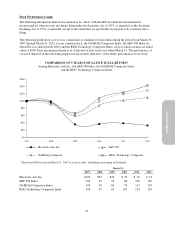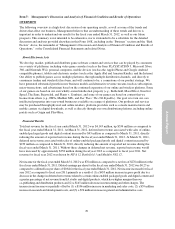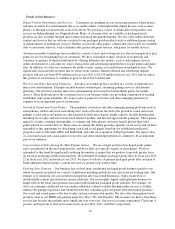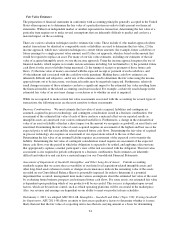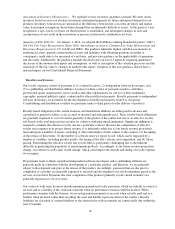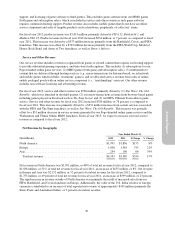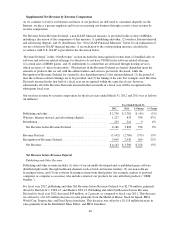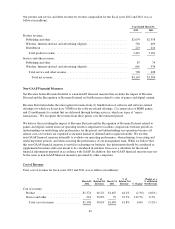Electronic Arts 2012 Annual Report Download - page 116
Download and view the complete annual report
Please find page 116 of the 2012 Electronic Arts annual report below. You can navigate through the pages in the report by either clicking on the pages listed below, or by using the keyword search tool below to find specific information within the annual report.•Collection is deemed probable. We conduct a credit review of each customer involved in a significant
transaction to determine the creditworthiness of the customer. Collection is deemed probable if we expect
the customer to be able to pay amounts under the arrangement as those amounts become due. If we
determine that collection is not probable, we recognize revenue when collection becomes probable
(generally upon cash collection).
Determining whether and when some of these criteria have been satisfied often involves assumptions and
management judgments that can have a significant impact on the timing and amount of revenue we report in each
period. Changes to any of these assumptions and judgments, could cause a material increase or decrease in the
amount of revenue that we report in a particular period.
Multiple-element arrangements
We enter into multiple-element revenue arrangements in which we may provide a combination of game software,
updates or additional content and online game services. For some software products we may provide updates or
additional content (“digital content”) to be delivered via the Internet that can be used with the original software
product. In many cases we separately sell this digital content for an additional fee. In other transactions, we may
have an obligation to provide incremental unspecified digital content in the future without an additional fee (i.e.,
updates on a when-and-if-available basis) or we may offer an online “matchmaking” service that permits
consumers to play against each other via the Internet. Collectively, we refer to these as software-related
offerings. In those situations where we do not require an additional fee for the software-related offerings, we
account for the sale of the software product and software-related offerings as a “bundled” sale, or multiple
element arrangement, in which we sell both the software product and relating offerings for one combined price.
Generally, we do not have VSOE for the software-related offerings and thus, we defer net revenue from sales of
these games and recognize the revenue from the bundled sales games over the period the offering will be
provided (the “offering period”). If the period is not defined, we recognize revenue over the estimated offering
period, which is generally estimated to be six months, beginning in the month after delivery. In addition,
determining whether we have an implicit obligation to provide incremental unspecified future digital content
without an additional fee can be difficult. Determining the estimated offering period is inherently subjective and
is subject to regular revision based on historical online usage.
Determining whether an element of a transaction constitutes an online game service or a digital content download
of a product requires judgment and can be difficult. The accounting for these transactions is significantly
different. Revenue from product downloads is generally recognized when the download is made available
(assuming all other recognition criteria are met). Revenue from an online game service is recognized as the
service is rendered. If the period is not defined, we recognize the revenue over the estimated service period. For
example, our MMO games have an estimated service period of eighteen months, beginning in the month after
delivery.
For our software and software-related multiple element arrangements (i.e., software game bundled with software-
related offerings), we must make assumptions and judgments in order to (1) determine whether and when each
element is delivered, (2) determine whether the undelivered elements are essential to the functionality of the
delivered elements, (3) determine whether VSOE exists for each undelivered element, and (4) allocate the total
price among the various elements. Changes to any of these assumptions and judgments, or changes to the
elements in the arrangement, could cause a material increase or decrease in the amount of revenue that we report
in a particular period.
In some of our multiple element arrangements, we sell tangible products with software and/or software-related
offerings. These tangible products are generally either peripherals or ancillary collectors’ items. Prior to April 3,
2011, because either the software or other elements sold with the tangible products were essential to the
functionality of the tangible product and/or we did not have VSOE for the tangible product, we did not separately
account for the tangible product. On April 3, 2011, we adopted FASB ASU 2009-13, Revenue Recognition
(Topic 605): Multiple-Deliverable Revenue Arrangements and ASU 2009-14, Software (Topic 985): Certain
Revenue Arrangements that Include Software Elements. The new accounting principles establish a selling price
32







